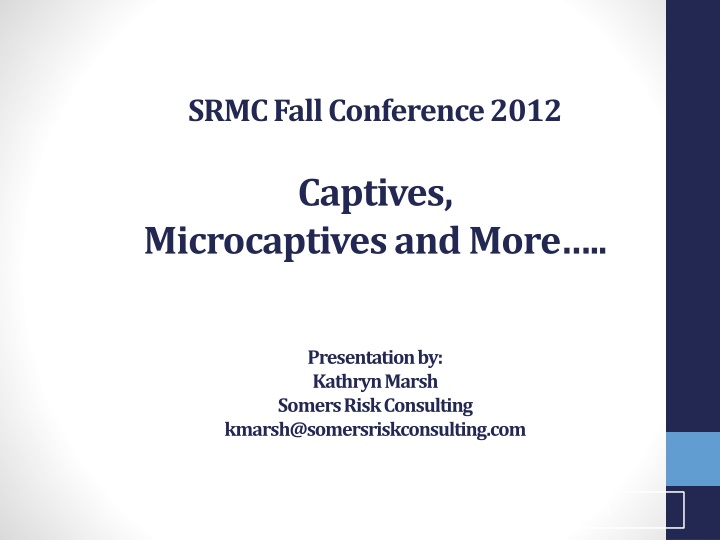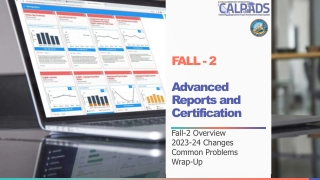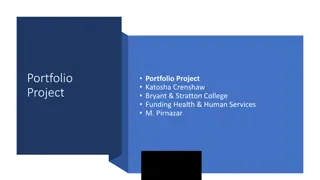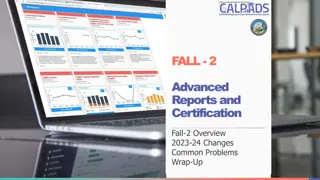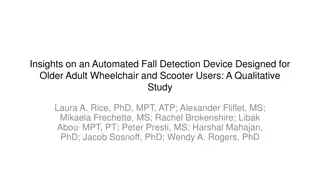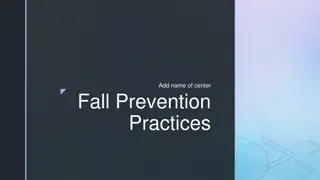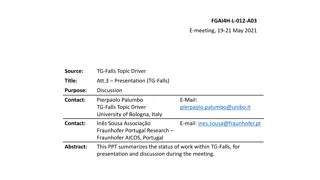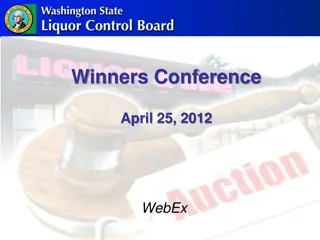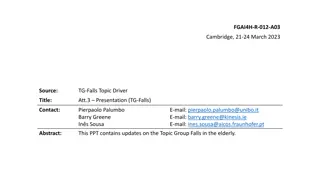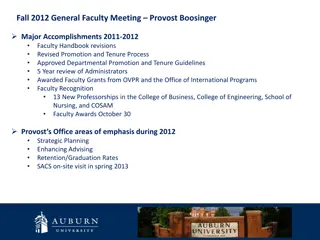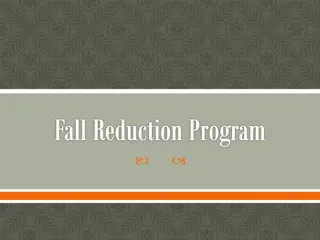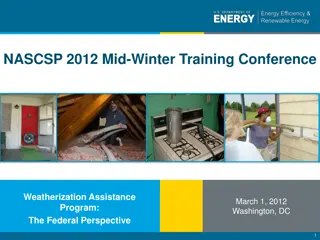SRMC Fall Conference 2012: Captives & Microcaptives Overview
Dive into the world of captives and microcaptives with insights from Kathryn Marsh of Somers Risk Consulting. Explore the characteristics, reasons, and types of captives, along with the benefits of micro-captive options such as risk management control, asset protection, and favorable tax treatment.
Download Presentation

Please find below an Image/Link to download the presentation.
The content on the website is provided AS IS for your information and personal use only. It may not be sold, licensed, or shared on other websites without obtaining consent from the author.If you encounter any issues during the download, it is possible that the publisher has removed the file from their server.
You are allowed to download the files provided on this website for personal or commercial use, subject to the condition that they are used lawfully. All files are the property of their respective owners.
The content on the website is provided AS IS for your information and personal use only. It may not be sold, licensed, or shared on other websites without obtaining consent from the author.
E N D
Presentation Transcript
SRMC FallConference2012 Captives, Microcaptivesand More .. Presentation by: Kathryn Marsh Somers Risk Consulting kmarsh@somersriskconsulting.com 1
Agenda Captive Overview Micro-captives Risk Pooling Arrangements Case Studies Steps for Looking at the Captive Option Q&A Info on Somers Risk and Bio Somers Risk Consulting 2102 2
What is a Captive? A captive is an insurance company that insures the risks of its owners, affiliates, or a group of companies. It issues policies, collects premiums, and pays claims.
Characteristics of Captives Licensed Insurance Company Formed to insure or reinsure the risk of its owners or unrelated parties of their choosing Regulated under special legislation regulating captives (regulated less stringently than state insurance laws which govern fully admitted insurance companies) Located offshore or onshore many domiciles available Admitted only in its domicile and non-admitted in all other jurisdictions.
Reasons to Form a Captive Somers Risk Consulting 2102 5
Types of Captives Single Parent Captive insures the risk of the owner and it subsidiaries, traditionally used by large companies Group /Association Captives owned & operated by a group of members; 100% of risk and assets pooled Sponsored/Rent-a-Cell /Segregated Cell/Series Captive owned & operated by a sponsoring entity; liabilities and assets legally segregated Micro-Captive/831(b) Captive is a single parent captive writing smaller premiums that has special tax benefits. These are focused on small to mid-size businesses. Somers Risk Consulting 2102 6
Micro-Captive option In recent years, increased focus on Micro-Captives as a result of: Increased awareness of this option amongst attorneys, financial planners, accounting firms, consultants, etc. Increased sophistication of small and medium sized companies Recognition of the following benefits: Heightened awareness of ability to control risk management costs Potential to insure and pre-fund enterprise risks Potential to share risk and decrease exposure to catastrophic or large losses Asset protection Favorable tax treatment Estate planning/wealth transfer Somers Risk Consulting 2102 7
What is a Micro-Captive? Section 831(b) of the IRS Code allows Property/Casualty insurance companies writing under $1.2 million in premium to be taxed on investment income only. They are not taxed on underwriting income. Somers Risk Consulting 2102 8
How does it work? Premium payments from company to insurance company are a tax-deductible expense Premium less losses/expenses = underwriting profits - grow in captive untaxed Annual therefore, ability to have significant tax-free growth Typically, tax will be paid on dividends when paid - currently at 15% dividend/capital gains rates Potential for no-tax exit strategy Somers Risk Consulting 2102 9
An Example Financials Assuming No Losses Single Year Insured Company s financials: Premium payment Tax Deduction After tax cost $1,000,000 400,000 $600,000 Net Cost = $600,000 Captive Insurance Company financials: Somers Risk Consulting 2102 Premium income Captive Admin Expenses Losses Underwriting Income Tax due After tax Retained Earnings $1,000,000 70,000 -0- Net Value = $930,000 930,000 -0- $930,000 Annual Benefit = $330,000* Assumptions: Captive qualifies as a bona fide insurance company Tax rate is 40% (combined federal and state) Investment income is ignored (will be subject to taxation typically federal only, not state) Assumes no losses. Loss activity will reduce benefit. There will be a capital requirement in the first year of captive formation - $120K minimum *Although tax savings are significant, the primary reason for forming a captive should not be tax motivation but to meet risk management needs. 10
An Example Financials Assuming No Losses After 5 Years Insured Company s financials: Premium payment Tax Deduction After tax cost $5,000,000 2,000,000 $3,000,000 Net Cost = $3,000,000 Captive Insurance Company financials: Somers Risk Consulting 2102 Premium income Captive Admin Expenses Losses Underwriting Income Tax due After tax Retained Earnings $5,000,000 350,000 -0- Net Value = $4,650,000 $4,650,000 -0- $4,650,000 Five Year Benefit = $1,650,000 Assumptions: Captive qualifies as a bona fide insurance company Tax rate is 40% (combined federal and state) Investment income is ignored (but will be subject to taxation typically federal only/not state) Assumes no losses. Loss activity will reduce benefit. There will be a capital requirement in the first year of captive formation - $120K minimum *Although tax savings are significant, the primary reason for forming a captive should not be tax motivation but to meet risk management needs. 11
An Example Estate Planning Vehicle With Captives owned by Three Heirs After 5 years Insured Company s financials: Premium payment Tax Deduction After tax cost $15,000,000 6,000,000 $9,000,000 Net Cost = $9,000,000 Reduction in Value of Estate Reduction in Estate Taxes Unknown but tax rates have been as high as 55-60% in past Assume 2012 35% Rate $ 5,250,000 $15,000,000 Somers Risk Consulting 2102 Total of Financials of Captive Insurance Companies owned by 3 Heirs : Premium income Captive Admin Expenses Losses Underwriting Income Tax due After tax Retained Earnings $15,000,000 1,050,000 -0- $13,950,000 -0- $13,950,000 Net Value = $13,950,000 Five Year Benefit = $5,250,000 + $4,950,000= $10,200,000 Assumptions: Captive qualifies as a bona fide insurance company Tax rate is 40% (combined federal and state) Investment income is ignored (will be subject to taxation - typically federal only/not state) Assumes no losses. Loss activity will reduce benefit. There will be a capital requirement in the first year of captive formation - $120K minimum *Although tax savings are significant, the primary reason for forming a captive should not be tax motivation but to meet risk management needs. 12
Good Candidates are Small to mid-size private companies Typically $10 million + in gross revenue Pre-tax profits of at least $1MM Stable cash flow Substantial self-insured / uninsured business risk Larger companies who intend to grow a captive over time but like the opportunity to start with a low capital base and an immediate quantifiable economic benefit Somers Risk Consulting 2102 13
Industries include: Construction Real Estate Transportation Agriculture & Livestock Manufacturers Professional/Financial Services Firms Franchisees Hospitality Medical Services Most! Somers Risk Consulting 2102 14
Types of Risk Work best for risks that have possibility but low probability of loss Somers Risk Consulting 2102 Enterprise risks that are currently not insured 15
Examples of Coverages Loss of Key Customer Loss of Key Supplier Loss of Key Contract Professional Misconduct Product Recall FDA Administrative Actions Liability Professional Liability Gap Coverage HIPAA/Billing Audit Liability Contractual Liability General Liability DIC Cyber Liability Intellectual Property Environmental Liability Product Liability DIC Directors and Officers Liability Regulatory Changes Punitive Damages Loss of Key Employee Deductible Reimbursement (Property, Workers Comp, General Liability, Product Liability) Patent Infringement/Intellectual Property Collections Product/Service Rework Labor Shortage/Strike Loss Reimbursement Employment Practices Employee Dishonesty
Further Considerations Captive must be considered a bona fide insurance company. Therefore, there must be risk spread and distribution from either: Several legal entities Source of 3rd party business Captive must operate in a manner consistent with traditional insurance companies Insured must be a current taxpayer in order to benefit from 831(b) status Must be able to justify premium level Must consider capitalization requirements (high policy limits typically mean higher capitalization especially with low frequency) Captive will typically incur costs of approximately $40-70K per year for captive management fees, audit and actuarial fees, domicile fees and travel. Somers Risk Consulting 2102 17
Risk Pools What and Why? Many companies don t have the appropriate risk spread to qualify as an insurance company Participation in a risk pool provides third party risk Various pools available but most are similar to those that follow Somers Risk Consulting 2102 18
Enterprise Risk Pool Quota Share % X Premium Quota Shared Premium Unrelated Premium Premium Risk Pool $0.89 A A s $4 x $18 = $18 $1.33 $4 $4 Captive $1.78 Total Pooled Premium = $18 $1.00 B s B $6 x $18 = $18 $6 $2.00 $6 Captive $3.00 $1.78 C C s $2.67 $8 $8 x $18 = $18 $8 Captive $3.55
Enterprise Risk Pool 115+ Pool Participants $50MM + in total pool premium No policy limits in excess of $1,000,000 The frequency layer of risk (the first 25% of all claims) is retained by either the captive or the insured Example: On a $1,000,000 claim in the pool (the max. policy limit), the first $250,000 will be paid by the insured business, or that business captive Somers Risk Consulting 2102 Participant share of pool varies from 0.034% to 1.294% Example: Assume the max loss for single claim covered by pool ($750,000) Loss paid by lowest percentage captive participant = $255 (0.034% x $750,000) Loss paid by highest percentage captive participant = $9,705 (1.294% x $750,000) All policies in the pool must meet strict UW guidelines established by the pool. 20
Terrorism Risk Pool Operating Business A Operating Business B Operating Business A s Captive Operating Business B s Captive Terrorism Insurance Provider ( Pool ) Operating Business C Operating Business D Operating Business C s Captive Operating Business D s Captive Each Operating Business will pay 30%-50% of its captive premium to the Pool in return for terrorism coverage. The Pool then reinsures its risk with each Operating Business Captive in the same percentage that the Operating business s premium represents. Example: Assume Operating Business A pays $200k to the Pool and that $200k premium represents 2% of all premiums received by the Pool. The Pool will then pay Operating Business A s Captive $200k to reinsure 2% of the Pool s total risk (i.e. 2% of all of the other participating Operating Business s risk). 9
Ownership Options Shareholders Shareholders Key Employees Key Employees Family Family Estate Plan Trust Estate Plan Trust Captive Captive
Estate Planning With a Captive Child Trust Mom / Dad Mom / Dad 1% 99% 99% LLC 1.2 M P&C Premiums Business Captive Investments
Case Study 1 Client Large Trucking Company Facts: Poor but improving loss experience, considerable resources committed to improvement High premiums, no credit for improving loss experience High AL deductibles, expensive premiums, limited cash available to establish captive Private Company, several subsidiaries, owned by Parents with 2 sons involved in business Solution: Established captive and wrote $150K xs $100K first year to keep premium and capital at affordable level. Qualified for 831(b) status and aided by favorable tax treatment. As funds in captive grew, company felt comfortable increasing retentions and decreasing commercial premium charge. Over time, increased deductibles to $500K, $750K and eventually became a qualified self-insured. Still use captive to write the self-insured risk. Write bob-tail liability exposure of independent drivers to provide a source of third party risk to strengthen tax position. Recently established an additional captive owned by the sons. As well as having a risk management purpose, this allows for transfer of wealth and serves as an estate planning tool.
Case Study 2 Client Time Share Company Facts: Wanted to establish captive as a risk management tool to ultimately have more control and less cost. Did not have enough subsidiaries to be qualify for favorable insurance accounting treatment. Solution: Identified source of third party business - sell credit life and unemployment insurance on loans they finance. Developed fronted program using an A-rated carrier Obtained appropriate licensing (limited lines licenses full agent s license is typically not required) Now have a substantial additional source of revenue and a tax-efficient captive !
Case Study 3 Client Time Share Company Facts (similar to prior case) Wanted to establish captive as a risk management tool to ultimately have more control and less cost. Also was motivated by estate planning need and desire for tax efficiencies of 831(b) IRS code. Did not have enough subsidiaries to be qualify for favorable insurance accounting treatment. Solution: We suggested credit life program but client did not want to go through training and licensing requirements. Established a captive owned by combination of parents and majority aged daughter. Used the enterprise risk pool arrangement . Sharing of exposures above primary layer for coverages including: regulatory risk, mold, general liability gap, cyber liability, etc. Accomplishing reduced exposure to large, previously retained losses and very tax efficiently transferring wealth to daughter and providing parent s with a retirement vehicle.
Case Study 4 Client Agricultural and Canning Facts: Wanted to build a fund to insure retained risk from high deductibles, environmental (holding ponds with potential substantial exposure), commodity risk and key customer/contract exposure Business owned primarily by 2 retiring brothers and several adult children involved in business estate planning motive Cash rich company Solution: Program is still under development but initially will establish 3 Micro-captives owned by combination of children. Will use the enterprise risk pool initially for first 3 captives. Will likely establish a forth Micro- captive using the terrorism pool. Accomplishes risk management goals and, at the same time, is transferring over $4 million out of the parent s estate each year in a very tax-efficient manner.
Case Study 5 Client MGA Facts MGA specialized in coastal homeowners policies mainly vacation homes. State flood pool covers this exposure and their program covers ex-wind. Have a large book of very profitable business with years of historical experience. Want to receive more of the profits than they are receiving under current commission structure Solution: Established an offshore captive (onshore domiciles typically do not like unrelated, third party risks). Established a fronted arrangement with an A-rated insurer. Write the business on a quota share basis with excess reinsurance, with captive taking most of the risk. Over time, intent is to write 100% of risk. In meantime, considerable profits that were previously transferred to insurance company, are being retained.
Why a Captive? Benefits to Client and Consultant
Why Captives are Formed Benefits to Client To reduce total cost of risk To provide increased control over risk management program To provide coverage where there is a lack of available coverage in marketplace To provide premium stability To create a new profit center To provide increased control over claims process To improve consolidated tax position
Additional Benefits to Consultant or Broker Proactively discussing the captive option wards off competitors who may use a captive presentation as a door opener. Promotes a sense of goodwill client recognition of the potential value- add and recognition that you are seeking options in client s best interest. Having a captive in place tends to tie a client more closely to the parties involved with that captive. Captive provides more options when marketing program in marketplace Good prospecting tool
Captive Feasibility Feasibility study = Does a captive make sense for us? Study should: identify potential risks of the captive and structure the program, ownership, select domicile, etc. analyze the business andfinancial effects of the captive on its owners discuss the cash flow/ tax benefits Provide all necessary information for owners to make an informed decision!
Captive Formation Process Captive makes business and financial sense. - Now What? Draft operations plan and financial projections Meet with regulators in chosen domicile Submit captive application & all required documentation to regulator. Educate, inform and respond to regulators. Amend business plan if necessary. Obtain approval. Incorporate & capitalize company.
For more information. Contact: Kathryn Marsh Somers Risk Consulting kmarsh@somersriskconsulting.com 770-645-2242 (o) 770-286-7551 (c) Somers Risk Consulting 2102 36
Kathryn Marsh, Managing Director Somers Risk Consulting Kathryn Marsh is a seasoned consultant within the alternative risk industry with over 30 years of experience in various facets of the industry. After many years of working for various large and small companies, she has formed Somers Risk Consulting which specializes in captive and alternative risk consulting and captive management. Prior to establishing Somers Risk Consulting, Kathryn held high level consulting positions with boutique captive consulting firms as well as large firms such as KPMG and AON. At AON she headed the company s regional quantitative and alternative risk groups, and was Chair of the company s Captive Council, a network of the key captive personnel worldwide. Her employment at KPMG was within the Structured Risk Financing Group of KPMG s Tax Practice where she was fully immersed in captive tax strategy. Kathryn also spent a number of years managing captive insurance companies in Bermuda with Marsh and was the Director of Risk Management for NCR Corporation. Most recently she was the insurance expert within the management team of a cell phone insurance company where she structured and implemented the risk program which helped grow the entrepreneurial company into one that was recently acquired by Brightstar, a $5 billion global distributor of mobile communication equipment. Somers Risk Consulting 2102 Kathryn has a Bachelor of Business Administration degree majoring in Insurance from St. John s University in New York and an MBA with a double major in Finance and Multinational Management from the Wharton School of the University of Pennsylvania. She holds the Chartered Property and Casualty Underwriter (CPCU) and Associate in Risk Management (ARM) designations. 37
